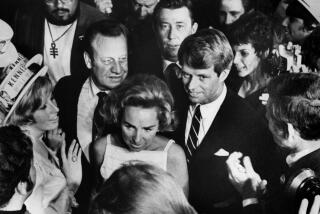Minneapolis Busy With Honors to Sister Kenny
- Share via
MINNEAPOLIS — Color it the autumn of the century here around the upper Mississippi River banks shared by the Twin Cities of Minneapolis and St. Paul.
Many events are helping to make it so, and nature is cooperating by tinting the leaves while the weather is still balmy enough for windsurfers to accent the season with the brilliant colors of their sails.
Arthur Frommer, whose books guide travelers around the globe, ranked Minneapolis-St. Paul among his 1986 choices for the Top Ten vacation spots in the world.
Documentary for BBC
The British Broadcasting Corp. is sending a TV crew here to document autumn events here.
This is the weekend to focus first on the event that is the heart and soul of autumn here this year, an event that will touch lives in every country.
Beginning this weekend, the Sister Elizabeth Kenny Centennial will reach out across the world from its center here, honoring the 100th birthday of the Australian nurse whose work is still helping to rehabilitate lives everywhere on earth.
It was nearly half a century ago that she founded in Minneapolis the institute for treatment of polio patients (pre-Salk vaccine) by then-revolutionary physical therapies that are still being developed for rehabilitation from other disabling illnesses.
Sister Honored
Hollywood, where the late Rosalind Russell starred in “Sister Kenny,” the film based on the nurse’s life, will be part of the centennial story here. It will share the remembrances with Times Square in New York City, where the movie had one of the great premieres in history, and with Washington, D.C., where the visionary sister was honored by the White House and Congress after the dark years when her trail-blazing concepts of physical therapy had been rejected by organized medicine.
There are more than 50 miles of surfaced walking, bicycling and wheelchair paths around the 22 lakes within the city limits of Minneapolis, and the byways continue above the 29 miles of St. Paul’s Mississippi river front and the University of Minnesota campus on both sides of the river.
About 6,000 runners will compete here in October for the national marathon championships. They’ll be part of a remembrance of young runners who were taught to walk again by Sister Kenny after they had been stricken by polio.
Alan Alda Helped
Alan Alda, who as a young polio victim was aided in his recovery by therapy at the Sister Kenny Institute, is one of many entertainers who have made the Twin Cities a center for theater and nightclub entertainment in the Midwest. Now on tour in Europe, he has sent in his story and tribute to be part of the centennial.
The Sister Kenny Institute at Chicago Avenue and 28th Street has become a place of pilgrimage on sightseeing tours mapped out for visitors to the Twin Cities. Many people who come here have a relative or friend who has been helped by the therapies practiced by staff alumnae throughout the United States and in many other countries.
The medical profession has embraced concepts it once rejected. Since Sister Kenny’s death in 1952 at her home in Toowoomba, Australia, now also a pilgrimage destination, it has become virtually impossible to receive any physical therapy anywhere that would not be related to the Sister Kenny Institute.
Dr. Richard R. Owen, the institute’s medical director and a polio victim in his youth, enriches the centennial with the story of what the institute has been doing since vaccines ended the polio epidemics. Stroke, spinal cord injuries, brain injuries and post-polio complications are high among priorities of therapy programs, and he is looking ahead to being able to help those afflicted with multiple sclerosis.
Inspiring Sculpture
It is inspiring to stand before the “Wellspring” sculpture in front of the Sister Kenny Institute on the Abbott-Northwestern Hospital grounds. Bronze figures rise in triumph above disabling afflictions as a child looks up from the base of the monument with an outstretched hand.
Elizabeth Kenny received her title as sister, a British designation of a nurse, after gaining experience in military nursing service with British and Australian troops during World I.
Her birthday was on Sept. 20 in Warrialda, New South Wales, Australia. Exhibits telling the story of her life and treatment of patients have been gathered for a first public showing here at the Sister Kenny Institute this birthday weekend and will be made a permanent part of the institute.
Sister Kenny’s portrait and a sculpture of her features will be centerpieces of the exhibit. So will a life-size photo of Russell in her role as Sister Kenny. They worked together in preparation for the film. When the movie premiered in New York City in 1946, with Sister Kenny present, more than 20,000 people jammed Times Square to see her.
My wife, Elfriede, and I have been here in Minneapolis watching the centennial exhibit being put together.
Photos Show Triumphs
The triumphal moments are all here: photos of the luncheon with President Franklin D. Roosevelt at the White House, the many meetings with the late Hubert H. Humphrey, who worked with her as mayor of Minneapolis, U.S. senator and vice president. The Gallup Poll once named her Most Admired Woman in America.
Congress passed a bill granting her entry into the United States at any time without a passport, an honor otherwise accorded only to the Marquis de Lafayette and Sir Winston Churchill.
But it wasn’t always so. When she arrived in Minnesota in 1940, her far-out ideas for physical therapy and hot packs, instead of immobilization of polio-stricken limbs in casts or braces, had been rejected by medical institutions in the United States.
This was to be her last stop in America before heading home to Australia, and it was here that she found the open minds and support for the first Elizabeth Kenny Institute. It opened on Dec. 17, 1942, at 1800 Chicago Ave., a few blocks from the present facility that was merged into the Abbott-Northwestern Hospital complex in 1975.
Children to Participate
This weekend, TV cameras will be focused on 100 children standing around the centennial birthday cake. They will be from the public elementary school named after Sister Kenny. A look-alike for Kenny will be dressed as she always was, including a flamboyant Aussie-style hat. It symbolized the toughness with which she fought for her ideas, in contrast to the gentleness she showed toward patients.
The ultimate Sister Kenny touch for visitors to the exhibit will be to find out that 1986, strictly speaking, is not the centennial of her birth. In 1915 she wanted to enter the military service and go from Australia to England to work with the wounded of World War I. But she was already 36 years old and didn’t think she would be accepted. So she changed her age to 29, her birth year to 1886, was accepted into the service of her country and went on to become Sister Kenny.
“That’s good enough for us,” said Nancy Rehkamp, the institute’s executive director. “This is her centennial year, the way she would have wanted it to be. We hope Australia will commemorate the spirit of Sister Kenny with a centennial stamp.”
Family Connection
The centennial has a personal poignancy for our family, as it will for so many who will see the exhibit this year and in the years to come.
When the raging polio epidemics of the late 1940s were taking lives and crippling victims all across the nation, my mother, who had been doing volunteer nursing work in Wisconsin, felt she should be helping polio patients. As Hilda Ryhlick, our family name, she came to Minneapolis and went to work for Sister Kenny.
Here we have come upon the stories of former patients, later successful in diverse walks of life, who were stricken as children and in their early teens. They are sharing memories of how my mother’s loving concern and help with their therapy inspired them to believe there could be life after polio.
Still very much running her own home near our home in Southern California, she is looking forward at age almost 92 to her 100th birthday, which she will dedicate to the Sister, who couldn’t live that long. She has written her recollections and sent photographs for this centennial commemoration.
More to Read
Sign up for The Wild
We’ll help you find the best places to hike, bike and run, as well as the perfect silent spots for meditation and yoga.
You may occasionally receive promotional content from the Los Angeles Times.






